The emergence, growth and governance of urban shared cycling systems derives from the strategies of operators (bike sharing companies), decision-makers (local and national authorities whose responses to new application-based transport services differ), users and the suppliers and users of other modes of urban transport [
36,
37]. In the case of China,
Figure 3 identifies the main stages in the industry’s evolution, mainly in terms of the number of companies and local and state authorities’ responses.
3.1. Launch of Bike-Sharing Systems
In China, public bike-sharing systems have been in use from 2007. At first, they were station-based systems governed by municipal governments. Municipal authorities were responsible for the distribution of bike stations, the maintenance of facilities and equipment and management, supported public bicycle programmes and even offered subsidies to bike-sharing companies.
From 2010 to 2014 some municipal governments authorized bike-sharing companies to operate and manage station-based systems. The launch of a new provider required municipal authorization, after which these services were self-financing. The providers made decisions as to the number and location of bike stations so as to minimize costs and maximize spatial coverage.
One of the largest bike-sharing companies was Yonganxing. In 2014, it provided services in over 200 mainly small and medium sized cities, proving that station-based systems could be successful in cities of these sizes [
28]. In these cities, a finite number of stations could meet cycling demand. In large cities however, costs prevented companies from providing sufficient stations. Spatial coverage was inadequate, and riders had to accept a degree of inconvenience. To some extent, station-based systems are similar to other station-centred public transport systems. The result was that there was potential demand for on-demand bike-sharing services, particularly in large cities. In addition, it is worth noting that the station-based model usually involved a membership system. Users had to sign up with municipal authorities or agencies, get a smart card and pre-pay cycling fees. The membership system contributed to the emergence of some loyal users of station-based systems, while the presence of existing members in a locality contributed to membership growth [
38]. However, station-based systems have a limited influence on shifts in travel behavior, and as indicated in
Section 2.1, the popularity of station-based systems declined due to their fixed distribution.
3.2. Emergence of Station-Less Bike Systems
Station-less bike-sharing systems emerged in August 2014, following on the tails of station-based systems. In some cities, the emergence of station-less systems decreased the market occupancy of station-based systems or even caused their failure. The number of station-less bike-sharing companies reached five in January 2016 (
Figure 4). There were three main reasons for the emergence of this new system namely traffic congestion, improvements in information technology, and the call for on-demand services.
Rising traffic congestion was a major issue in many mega-cities, leading some urban residents to switch from driving to public transportation and/or cycling. For short-distance trips, cycling is an alternative, saving both money and time. Generally speaking, users paid a deposit of 99 to 299 yuan (about 15 to 45 US dollars) when they signed up as a member of a bike-sharing system. Afterwards, the average cost of a cycling trip of less than one hour was not more than 1 yuan (about 15 US cents). When roads are gridlocked, cycling is faster than driving. For long-distance trips, public transportation is an alternative, but users still need bicycles to solve the first/last mile issue. A report showed that in 2016 average walking distance was about 0.94 km for a public transport trip [
39], and average public transport travel time was between 40.9 min and 53.8 min. Assuming that average walking speed was 4 km/h, average walking time accounted for at least 26% of a door-to-door public transport trip. Replacing walking by cycling significantly reduces the overall duration of public transport journeys by speeding up the first/last mile of the journey.
Improvements in information technology ensured that users could find bicycles almost everywhere. Companies equipped their bicycles with digital locks and GPS devices. Each bike-sharing company used a cloud server to operate its station-less system. Meanwhile, the spatial coverage of the 4G network expanded, and the popularity of smartphones grew. In China, smartphone ownership increased from 55% in 2013 to 65% in 2015 and continued to grow [
40]. The popularity of smartphones encouraged an application-based daily payments and service lifestyle. About 500 million smartphone users relied on application-based payments and were used to making payments by scanning QR codes.
Along with the call for on-demand services, the two aforementioned reasons explain the establishment of Ofo and Mobike. Ofo initially focused on campus cycling trips, starting operation in Peking University in June 2015 (
Figure 3). Mobike aimed from the outset at providing for cycling trips throughout a city, starting in Shanghai in April 2016.
In the early stages, a decision had to be made as to whether a station-less bike-sharing system should be confined to a certain area. Apparently, Ofo employed this strategy, but Mobike did not. Ofo made this decision because universities along with industrial zones are highly populated areas with a high demand for cycling. In these areas, Ofo acquired a high market share in the early years, and then in 2017 exported this system overseas, initially targeting campuses in Cambridge, Massachusetts and Silicon Valley. However, the distribution of bicycles over a whole city can increase the number of users in the long term.
At this stage, the only relevant government document was the guidance for promoting green consumption, issued by China’s national development and reform commission (NDRC) in March 2016. It encouraged low-carbon travel modes, including walking, cycling, and public transport. Following the establishment of a stream of application-based transport services, the NDRC also supported car-sharing applications and public bike-sharing programmes to facilitate green transport.
At the municipal level, there were no direct regulatory responses to station-less bike-sharing systems. It is worth noting that early-phase local and national state attempts to regulate and even forbid ride-hailing applications were unsuccessful. When station-less systems entered the market, local and state authorities did not prohibit their emergence, letting the outcomes reflect the interaction of suppliers and users.
3.3. Stage of Rapid Growth
From October 2016 and May 2017 rapid bike-sharing market growth occurred (
Figure 3;
Figure 4). The number of registered users grew to over 80 million [
2]. Companies that had previously operated station-based systems started to employ station-less systems.
In this period bike-sharing companies continuously increased the number of cities served. As Mobike’s system was working smoothly in Shanghai, between September and October 2016 it was introduced in Beijing, Shenzhen and Guangzhou. To compete with Mobike, Ofo expanded its services from campuses to the whole city. This expansion of service coverage made Ofo and Mobike the two largest companies.
Figure 5 shows the cities they served in May 2017. In general, bike-sharing companies usually distributed bicycles in four mega cities, namely Beijing, Shanghai, Guangzhou and Shenzhen, subsequently adding provincial capitals. By May 2017, all provincial capitals had at least one station-less system.
At this stage the major issue was the rapid entry of new suppliers and intense competition, with the number of companies increasing from seven to over thirty, and with rapid increases in the number and distribution of bicycles in the cities they served. Other problems encountered in this phase were the increasing occupation of urban space by bicycles and the exacerbation of already serious parking disorder.
Local municipal authorities supported the rapid growth of station-less systems due to their contribution to a green lifestyle and improved public health. As shown in
Figure 3, the first regulatory document was issued in Shenzhen in December 2016. This document sought to encourage and guide the development of station-less systems and clarified the responsibilities of related sectors. Primarily, the transportation and city management sectors were made responsible for the planning of bicycle lanes and parking zones. Municipal district and city management authorities were required to avoid disorderly bicycle parking, and the traffic police department was made responsible for dealing with traffic incidents involving shared bicycles.
Initially, many companies registered as internet rather than transport companies. The Shenzhen regulation, however, referred to bike-sharing companies, requiring the companies involved to register in both the commercial and transportation administration sectors. Under this regulation, the companies were required to report on their service coverage, number of bicycles, pricing arrangements and regulations relating to traffic accidents. Companies were advised to adopt advanced technology to monitor bicycle usage and ensure device quality. Companies were also made responsible for all aspects of cycling trips, including for example, accident insurance and security of the deposits paid by users.
Following Shenzhen, six other cities issued policies to regulate station-less systems, transforming the bilateral relationships between operators and users into trilateral relationships between supply, demand and government. These local regulations did not establish uniform overall standards governing station-less systems. For example, some local regulations included provisions relating to the risks attached to the deposits paid by riders, while others did not. Some local authorities set the minimum age of riders at 12 years, while others specified restrictions relating to their height.
3.4. Consolidation Stage
From May 2017, the bike-sharing market entered a supplier consolidation stage (see
Figure 3 and
Figure 4). One change related to market shares. During the period of rapid growth, the users registered with most companies increased continuously, with all of the companies focusing on marketing. In the consolidation stage, the relative competitiveness of large companies increased, as did their share of all users (see
Figure 4). However, the overall speed of increase in user numbers slowed down. In these circumstances, small companies gradually withdrew from the market or collapsed, as in the case of Wukong (see
Figure 3). These failures were mainly due to a loss of market share.
In general, one might expect the number of shared bikes to be correlated with the morphology and climate of cities. However, companies paid little attention to these factors and put as many bikes as possible onto the market. This strategy accelerated the failure of small companies. As
Figure 4 shows, between June and September 2017 the number of bike-sharing companies decreased from 30 to 26, and it continued downwards to 17 April 2018. In addition, many bike-sharing companies adopted new strategies, and instead of offering subsidies and/or free rides to attract users and increase their competitiveness, removed them in an attempt to cover costs and increase their financial sustainability.
At this stage, authors of third-party applications offered to handle payments for the users of multiple bike-sharing applications. This service made payments much more convenient and helped integrate the market. For example, Alibaba decided to invest in, and integrate, the bike-sharing market. Its payment application, Alipay, offered access to various bike-sharing applications. The Alipay platform listed available bike-sharing applications for each city, although it excluded Mobike, as access to Mobike was provided by WeChat Pay, another third-party payment application.
At this stage, after a four-month period of consultation with companies and users, the Ministry of Transport designed a national regulatory framework. In May 2017, the Chinese cycling association established a separate sector for station-less bike-sharing companies. These steps were designed to establish national service norms for station-less systems and a national industrial community for bike-sharing systems. Then the General Administration of Quality Supervision, Inspection and Quarantine issued the first report on station-less bikes, indicating that 12.5% of station-less bikes fell short of quality standards, making them a safety risk for users.
Table 2 summarizes this discussion of supply and governance issues. As Shaheen and Martin argued, station-based and station-less systems should suit different sizes of cities [
41]. Station-less bike-sharing systems have higher maintenance costs than station-based systems. Station-less systems provide greater flexibility with a large number of bicycles spread across a wide area, while station-based systems provide limited bicycles in a finite region. Consequently, station-less systems can solve the first/last mile issue, but cause parking disorder, whereas station-based systems have the opposite characteristics. Because of these characteristics, station-less systems are suitable in large and populous cities, while station-based systems work well in small- and medium-sized cities. A further advantage of station-less systems is that, given the wide availability of smart phones, it is easy to sign up. Joining station-based systems is more complicated. However, station-based systems can ensure the security of deposits, while users of station-less systems risk their deposits. For this reason, an analysis of user and non-user perspectives is necessary.
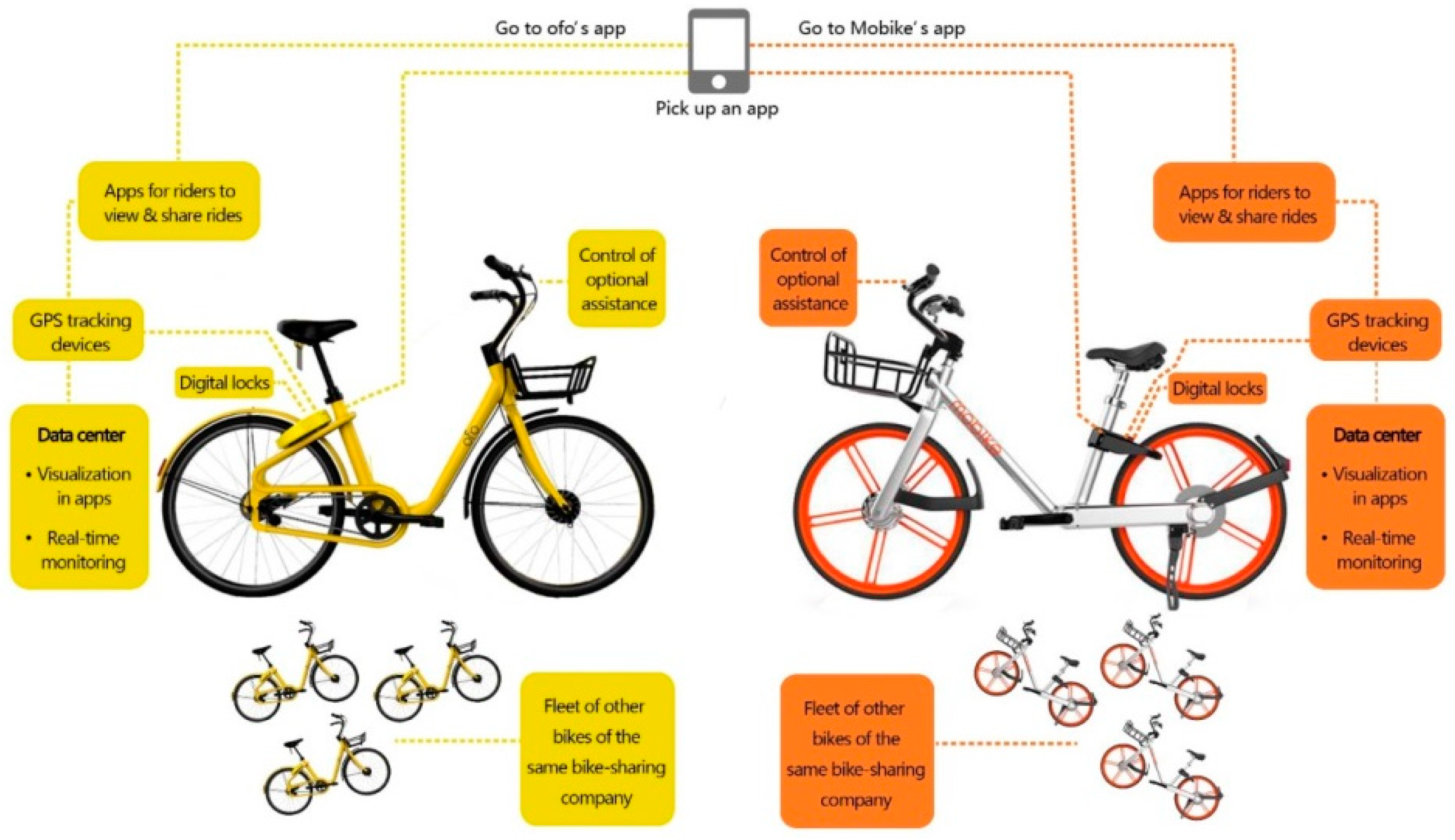
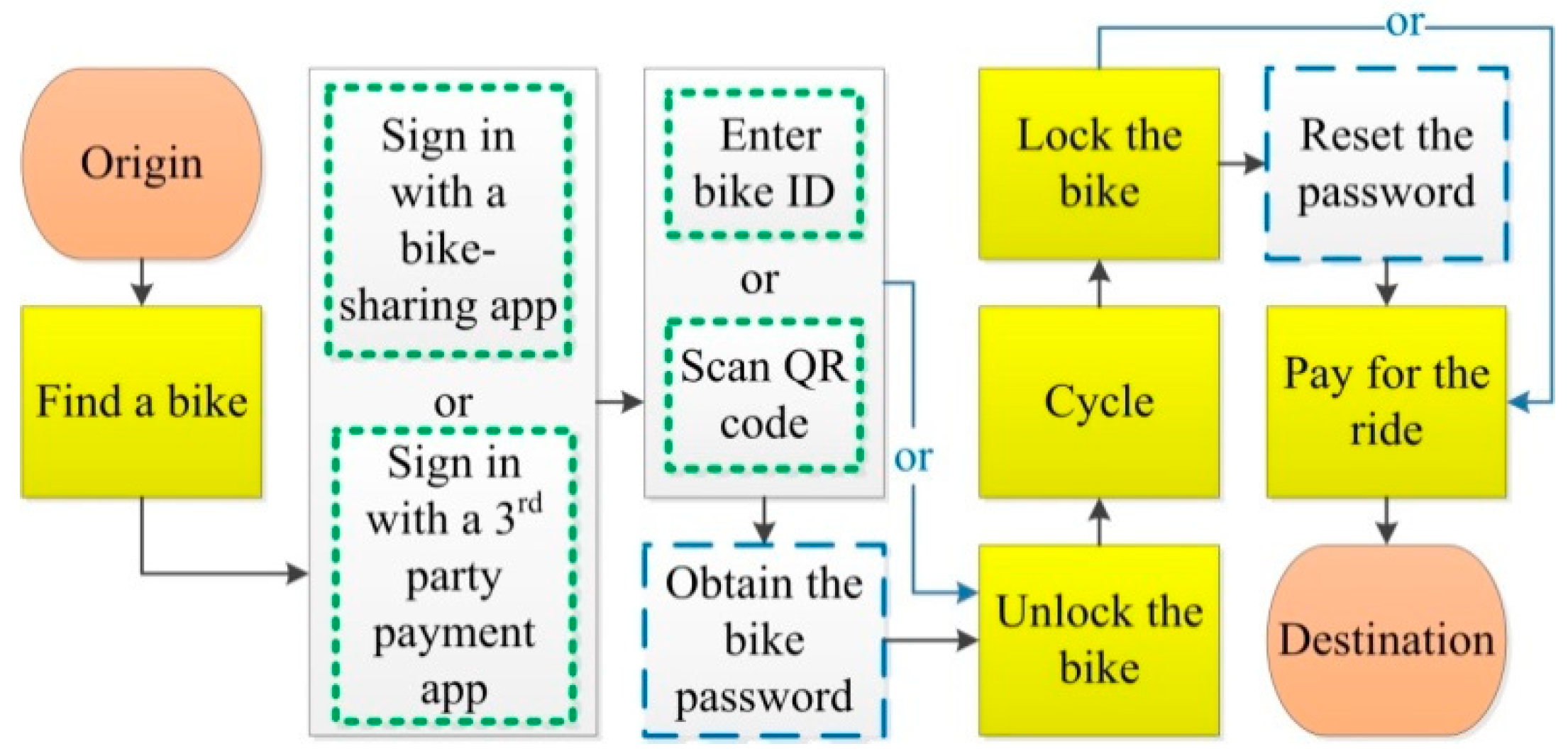
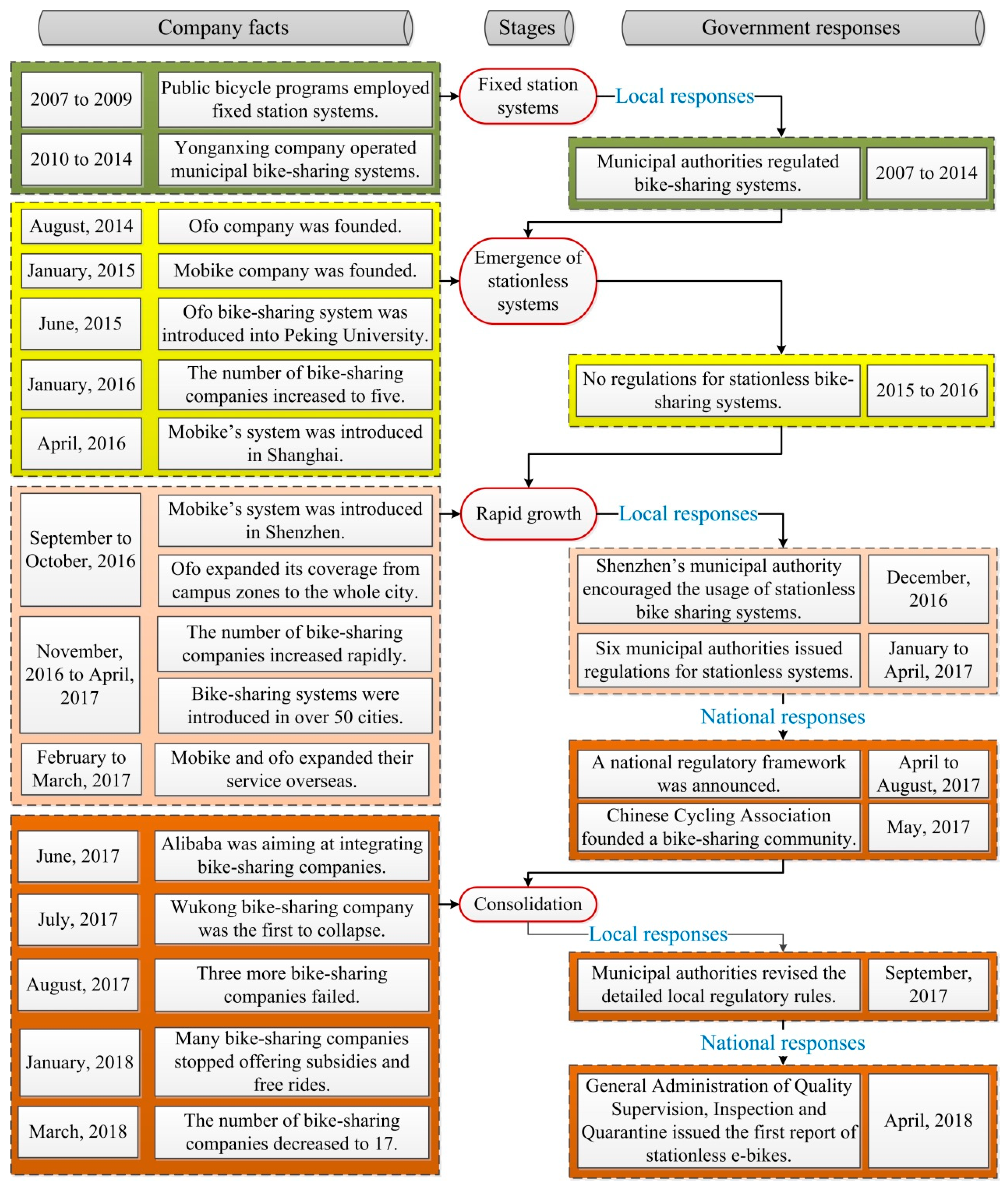
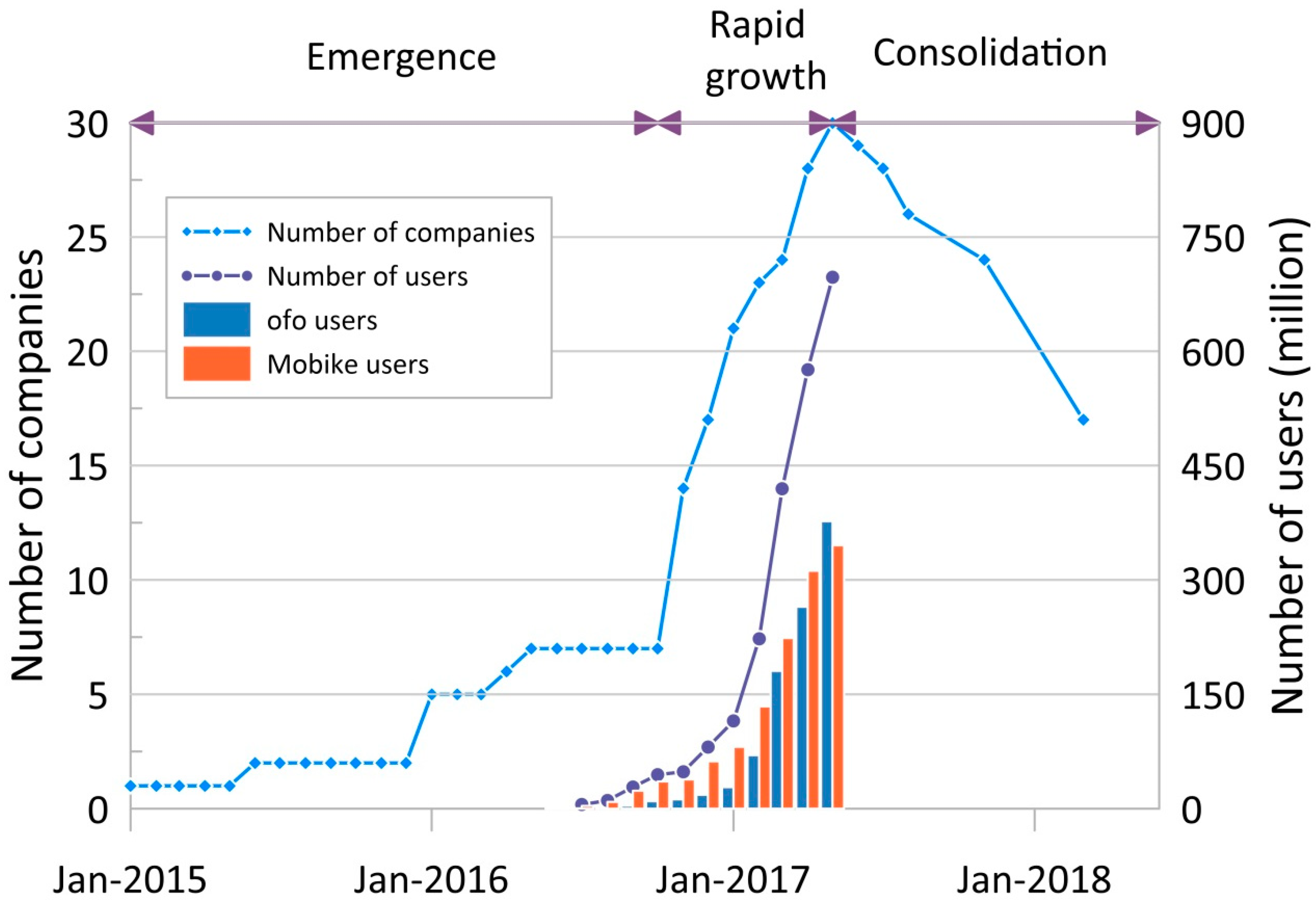
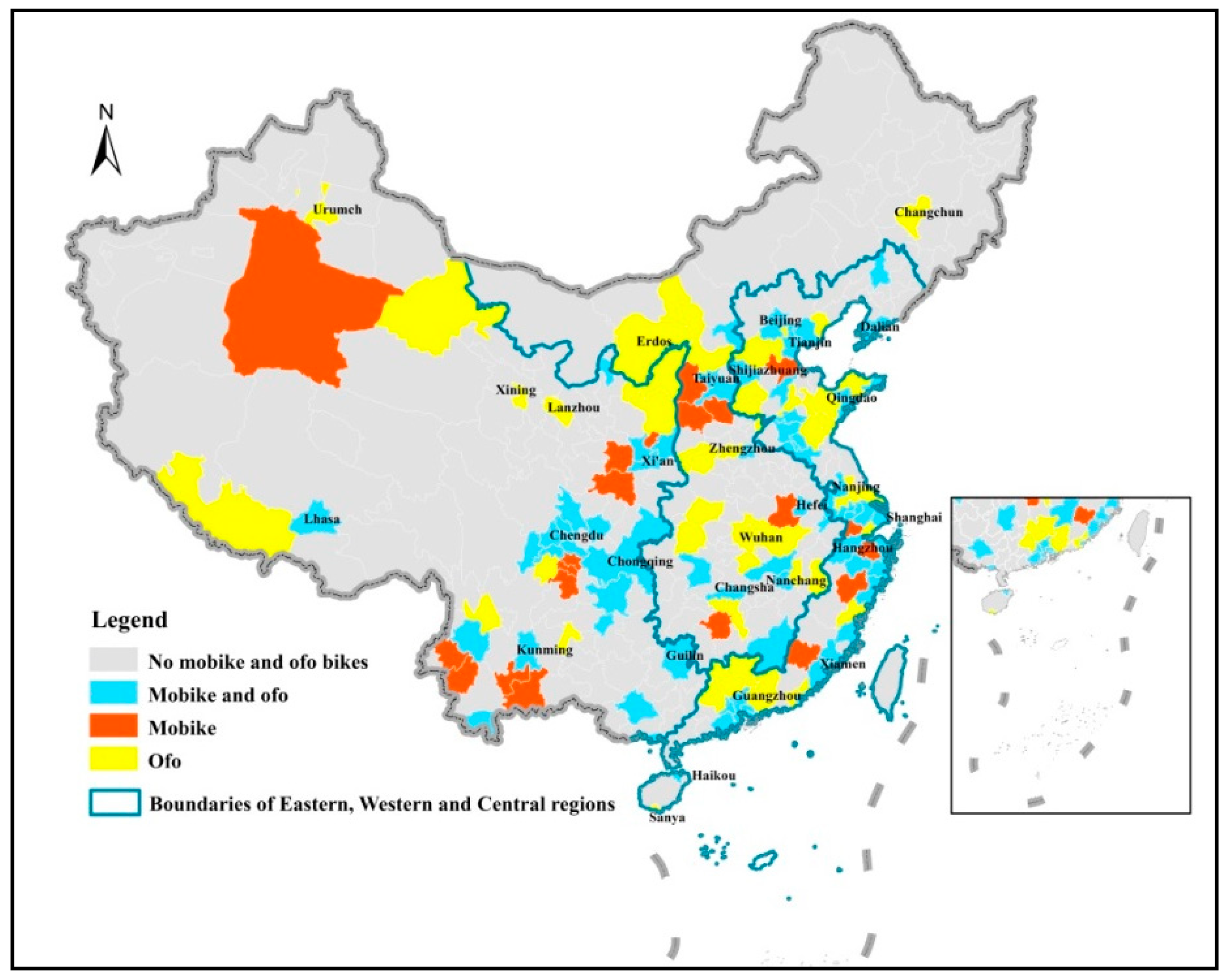
 76.79%
76.79% 72.27%
72.27% 27.6%
27.6% 5.4%
5.4% 3.89%
3.89% 3.76%
3.76% 5.9%
5.9%




